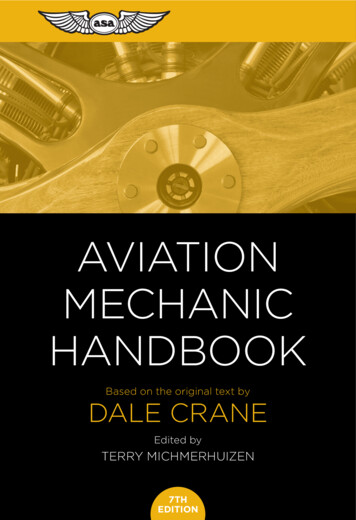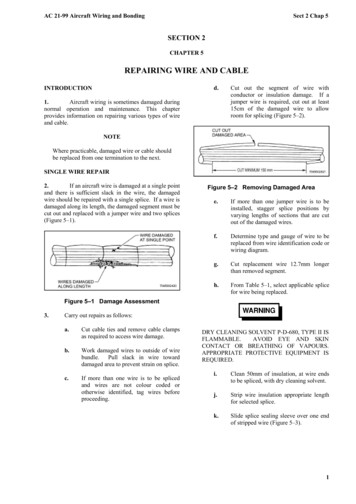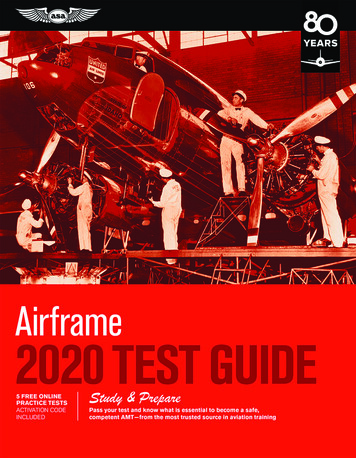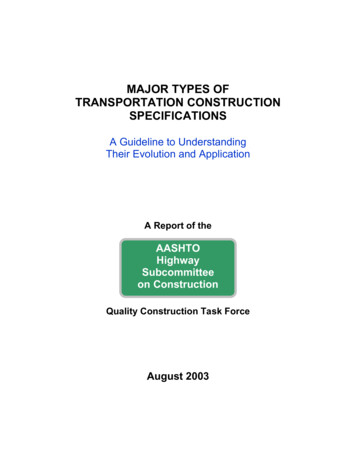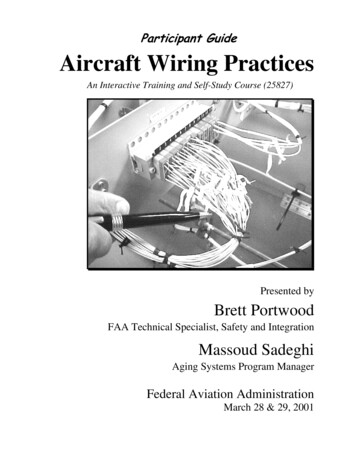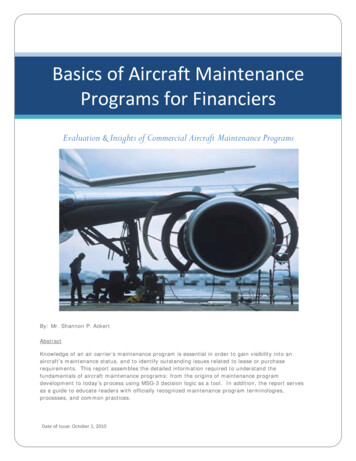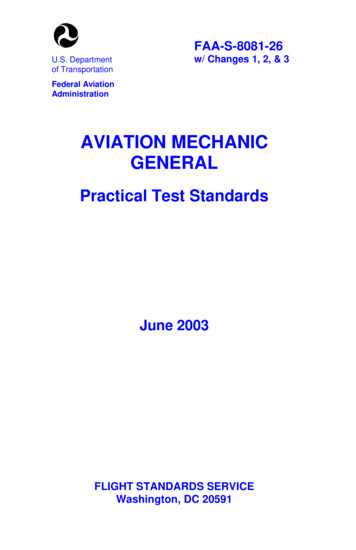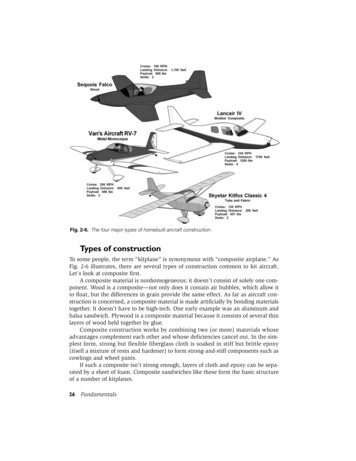
Transcription
Wanttaja CH 1 to 47/19/0512:27 PMPage 26Fig. 2-6. The four major types of homebuilt aircraft construction.Types of constructionTo some people, the term “kitplane” is synonymous with “composite airplane.” AsFig. 2-6 illustrates, there are several types of construction common to kit aircraft.Let’s look at composite first.A composite material is nonhomogeneous; it doesn’t consist of solely one component. Wood is a composite—not only does it contain air bubbles, which allow itto float, but the differences in grain provide the same effect. As far as aircraft construction is concerned, a composite material is made artificially by bonding materialstogether. It doesn’t have to be high-tech. One early example was an aluminum andbalsa sandwich. Plywood is a composite material because it consists of several thinlayers of wood held together by glue.Composite construction works by combining two (or more) materials whoseadvantages complement each other and whose deficiencies cancel out. In the simplest form, strong but flexible fiberglass cloth is soaked in stiff but brittle epoxy(itself a mixture of resin and hardener) to form strong-and-stiff components such ascowlings and wheel pants.If such a composite isn’t strong enough, layers of cloth and epoxy can be separated by a sheet of foam. Composite sandwiches like these form the basic structureof a number of kitplanes.26Fundamentals
Wanttaja CH 1 to 47/19/0512:27 PMPage 27How does it work? Imagine an ordinary piece of paper. It’s easy to tear and fold,but it resists stretching. Imagine, now, a sheet of Styrofoam. The foam resists bendingand crushing but crumbles when stretched.Glue a sheet of paper on either side of the foam. Apply a bending load, and thetension strength of the paper resists. Inserting the foam has changed the bendingmoment (to which the paper has little resistance) to a stretching moment.The advantage of composite construction is the easy workability of the component materials. The fiberglass cloth can be cut by a scissors, the foam can be cut orshaped by ordinary hand tools or a hot-wire “cheese slicer,” and the epoxies are easily mixed and applied.The two basic types of aircraft composite construction are molded and moldless.The first uses a mold to define the shape of the structure; fiberglass layups are madedirectly on the mold, allowed to harden, and then removed; the mold is then readyto make another piece. These are your fundamental composite kitplanes, wherefuselage halves and wing panels are supplied with the kit. Because the molds areexpensive and time-consuming to make, molded construction is best suited formass-produced kitplanes. Examples include the Lancair IV, the Glasair, and severalother aircraft.Moldless composite aircraft can be built in a number of ways. Most common isto build the basic structure out of wood, glue foam to the structure, then carve out thedesired shape, and apply the fiberglass and epoxy. Or one can eliminate the wood andcarve the shape from foam alone. The moldless method is used for the Velocity, theCo-Z, and the Vision.There is actually a third type of composite, called Taylor paper/glass (TPG)after its inventor, the legendary Molt Taylor. TPG, used on Taylor designs such asthe Mini-Imp (Fig. 2-7), uses a type of cardboard for its core material.Metal-monocoque construction is used by aircraft manufacturers from Piper toBoeing. A thin sheet of flat metal is pretty flimsy. But roll the metal into a wide tube,and it becomes stiff. Attach some bulkheads inside to prevent the tube from collapsing under heavy loads, and you’ve got a light, strong structure ideal for aircraft.The metal of choice is aluminum that is alloyed with other metals to optimizeits characteristics. Typical aluminum homebuilts include the Van’s Aircraft RV series, the Murphy Rebel, and the Zenith line.Tube-and-fabric construction is another of the traditional ways to make lightaircraft. The main structural shape of the fuselage is defined by a metal truss. Thewing can be built in one of several methods. The spars, for example, can be solidwood, built-up wooden boxes, or metal extrusions. The ribs can be stamped metal,cut plywood, built-up shapes, or even foam. Fabric is applied to the structure,hence the term “ragwings,” and then sealed with dope to produce an enclosed,streamlined shape. Commercial tube-and-fabric light planes include the Piper Cubseries and the Aviat Husky.Tube-and-fabric kitplanes use prewelded steel tubing, such as the Kitfox, oraluminum tube with gussets or extrusions pop-riveted in place, such as the MurphyRenegade.Wooden aircraft are built just like scale balsa models. The fuselage structure consists of longerons and bulkheads glued into the proper shape. As with tube-and-fabricThe kitbuilding process 27
Wanttaja CH 1 to 47/19/0512:27 PMPage 28Fig. 2-7. The Mini-Imp uses a third method of composite construction, Taylor paper/glass.Mini-Imp Aircraft Company.aircraft, the wings can be built in several ways and are either sheathed in plywoodor covered with fabric. Wooden kitplanes include the Fisher R-80 Tiger Moth replicaand the Sequoia Falco.The preceding is only a general guide—all kitplanes incorporate welded-steelcomponents, require builders to fabricate fittings from aluminum, and usually needsome fiberglass work (Fig. 2-8). Sometimes major components even use differentconstruction modes. The fuselage of the GlaStar consists of a steel-tube frameworkcovered by a composite shell; its wings and tail are of conventional metal-monocoqueconstruction. Even composite airplanes such as the Velocity embed wood hardpointsin the fiberglass for bolt attachments.Generally, designers keep to one major mode of construction throughout. Notonly does it make the parts list simpler, but also it reduces the construction timebecause the builder won’t have to learn two unrelated skills.Advantages/disadvantagesEach type of construction method has its own advantages and disadvantages bothduring construction and afterwards.Composite construction is the most controversial. There’s no question that themost streamlined shapes are produced by composites and that it’s far easier to bondtwo fuselage halves than to jig up bulkheads and drive 10,000 rivets. Composites28Fundamentals
Wanttaja CH 1 to 47/19/0512:27 PMPage 29Fig 2-8. Just because you pick one type of construction, don’t expect to escape working withother materials. This wing assembly features aluminum-tube spars, wooden ribs, and a fiberglass wingtip.don’t rot like wood; they don’t corrode like metal. And no one doubts the strengthof composite aircraft.Curiously, its very strength works against it. Controversy rages regarding thecrashworthiness of composite airframes. Composites have no “give.” A metal aircraft slightly deforms on impact and absorbs some of the crash forces before theycan affect the occupants. Composite structures maintain their shape against highforces and then shatter, allowing those forces to be transmitted to the passengers.Yet this doesn’t always seem to be true. In one well-publicized case, a compositeaircraft prototype crashed into a housing development after an engine failure. Twohouses, a van, and the plane were wrecked, but the aircraft occupants walkedaway.However, another important point is repairability. Major damage to a structuralcomponent usually will require replacement of the entire component. One then musthope that the kitplane manufacturer is still in business and still retains the molds forone’s particular aircraft model. This doesn’t mean that minor damage isn’t repairable,though. With new production composite aircraft such as the Cirrus and the Diamond,the repair techniques are fairly well established.Yet another drawback is temperature sensitivity. Some composite formulationslose strength when warmed excessively, such as might happen if the plane sits outdoors in the sun for long periods. The FAA requires that certificated composite aircraft,mostly sailplanes, be painted white to reduce this problem.The kitbuilding process 29
Wanttaja CH 1 to 47/19/0512:27 PMPage 30Speaking of sensitivity, some composite kitplane builders develop allergies to thematerials used. The introduction of safer epoxies has reduced this occurrence, butalways follow handling and safety instructions.One thing that can’t be escaped is the odor. The epoxies have a strong chemicalsmell and require excellent ventilation of the workspace. In addition, these chemicals must be used within particular temperature ranges, and the workshop thereforemight have to be heated during the winter months.Metal-monocoque and tube-and-fabric construction methods have several advantages over composite. Crashworthiness is good, aluminum or steel allergies are almostunheard of, and aluminum or fabric-covered aircraft can be painted any desired color.However, metal is not as easily formed into the swoopy curves necessary for highspeed aircraft. Aluminum can be bent into complex shapes, but the necessary skillstake time to learn.On the plus side, aluminum doesn’t care what the temperature is, so one doesn’thave to heat the workshop as long as the builder doesn’t mind bundling up. However, if the exterior skin (aluminum or fabric) is installed in the cold, wrinkles canappear during the summer. Unlike composites, there are no special restrictions onexposure to the elements. But outside storage in coastal areas can accelerate thecorrosion process.Approved procedures exist for repair of damaged monocoque or tube aircraft.However, if a metal tube kit comes with a prewelded fuselage, you won’t acquirethe skills necessary to repair the fuselage should it get damaged. For persons bothaccident-prone and pain-sensitive, aluminum construction uses many sharp toolsand creates sharp edges on metal.Wood has a combination of the advantages and disadvantages of the other construction modes. Like composites, wood construction requires a climate-controlledworkshop, and the finished aircraft must be protected from the elements. Like metalconstruction, wooden aircraft have good crashworthiness, and approved damagerepair methods assist reconstruction. Because of the nature of the material, woodenkitplanes include fewer precut parts and generally require more work on the part ofthe builder. Additional skills might be required because the builder must learn tomake scarf joints in plywood and to gusset and nail other joints and the myriad othertasks of the woodworker. However, this problem is reduced in modern kit aircraftsuch as the Loehle line of World War II fighter replicas (Fig. 2-9).Some advantages of wood are subjective in nature. Sawdust is a far more pleasantaroma than that of composite epoxies and is easier to vacuum than metal chips.Wooden airplanes seem more solid and quieter than other types. While wood rot isstill somewhat of a problem, modern preservatives drastically reduce the danger.The 51 percent rule and youRecall the various subgroups under the experimental category; experimental/amateurbuilt aircraft are under the strict limitation of the 51 percent rule.The rule exists to prevent the sale of nearly-ready-to-fly aircraft that do not meetthe requirements of standard category. We’ve already explained the process involvedin certificating a factory aircraft and how this process ensures stable and predictably30Fundamentals
Wanttaja CH 1 to 47/19/0512:27 PMPage 31Fig 2-9. Many modern wooden kits, such as this Loehle P-40, feature prefabricated components and reduced construction time.handling aircraft. Without the 51 percent rule, a manufacturer could bypass the regulations merely by requiring the installation of a few small parts. Such kits are allowedin the light sport aircraft category, but more stringent controls are applied to LSA kits(see Chap. 3).As mentioned earlier, the 51 percent rule came about in response to some poorlyengineered modifications of existing planes. However, this doesn’t mean that you can’tuse components of existing aircraft. Few FAA inspectors will complain if the entirefirewall-forward section of a factory airplane appears on your homebuilt. Severalolder homebuilt designs, such as the Breezy, even use complete wings from factoryplanes. However, these homebuilts are complex enough to make up for the existingparts.One good fallout from the popularity of homebuilt aircraft has been a certainamount of standardization and centralization on the part of the FAA. The FAA now hasa standard process for determining whether a given kit qualifies under the 51 percentrule, and the agency publishes this list online as the “Revised Listing of AmateurBuilt Aircraft Kits.” Using a search engine such as Google or Yahoo, search for“amateur-built aircraft kits.” The FAA list typically comes up very early in thesearch window; look for a link to the file name “ama-kits.pdf.”Note that if a kit isn’t on the list, that doesn’t mean that it can’t be certified as anexperimental/amateur-built airplane. The list is just designed to make things easierfor the individual FAA regions.The kitbuilding process 31
Wanttaja CH 1 to 47/19/0512:27 PMPage 32While it’s up to the kit manufacturer to ensure that its product meets the rule,you’re the one who’ll suffer if the FAA refuses to license your airplane as amateurbuilt. All you could ever expect to recover is the cost of the kit, and kitplane manufacturers go out of business with sad regularity.But there’s another way the 51 percent rule can cause you problems, although notwith the FAA. Let’s take a look at the rule from another perspective. Let’s say thata kit manufacturer proudly states, “Our kit meets the 51 percent rule.” So you orderthe kit, and when you open the box you find Sketches of an aircraft design The deeds for a bauxite mine in Oregon and an iron mine in Minnesota Six spruce logs and a chainsaw A dead cow and instructions for how to make glue from the carcassThis meets the 51 percent rule—and how!Truism Number One. “The 51 percent rule means that th
Wood is a composite—not only does it contain air bubbles, which allow it to float, but the differences in grain provide the same effect. As far as aircraft con- struction is concerned, a composite material is made artificially by bonding materials together. It doesn’t have to be high-tech. One early example was an aluminum and balsa sandwich. Plywood is a composite material because it .
